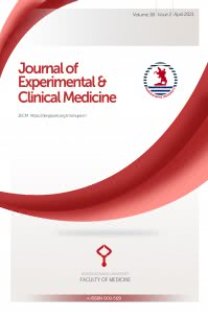Behçet hastalığında sinoviyal sıvı sitokin düzeyleri ve erozyon gelişimi ile ilişkisi
Son yıllarda kıkırdak ve kemik dokusunda erozyon gelişiminde sitokinlerin önemli rol oynadığı gösterilmiştir. RA'de erozyon gelişimi karakteristik bir bulgu iken, periferal artritin sık görüldüğü BH'nda erozyon nadiren görülmektedir. Aynca BH'nda sinoviyal sıvı sitokin düzeylerini gösteren bir çalışma bugüne kadar yapılmamıştır. Bu nedenle bu çalışmada BH'nda sinoviyal sıvı sitokin içeriklerini belirleyerek RA ve OA'li hastalardaki bulgularla karşılaştırmayı amaçladık. Çalışmaya ortalama yaşları sırası ile 32±9, 43±10 ve 59±4 olan 14 BH (11 erkek, 3 kadın), 15 RA (3 erkek, 12 kadın) ve 15 OA (2 erkek, 13 kadın) olmak üzere toplam 44 hasta alındı. Hasta gruplarında rutin romatolojik incelemeyi takiben artrosentez yapılarak sinoviyal sıvı örnekleri elde edildi. Tüm hastaların sinoviyal sıvı örneklerinde ELİSA yöntemiyle interlökm-1 beta (İL- 1 $\beta$), tümör nekrozis faktör alfa (TNF-$\alpha$), interlökin-8 (IL-8), solubl interlökin-2 reseptörü (sIL2R), transforming growth faktör beta (TGF-$\alpha$) ve interlökin-1 reseptör antagonist! (IL- 1ra) düzeyleri çalışıldı. BH ve RA'de sinoviyal sıvı IL-8 düzeyleri OA grubundan yüksekti (sırasıyla p
Synovial fluid cytokine levels in behçet' s disease
Recently cytokines have been shown to play important roles in the development of erosions of cartilage and bone. Although peripheral arthritis is common in Behçet's Disease (BD), erosions which are characteristic features of rheumatoid arthritis (RA) are rare. Moreover synovial fluid (SF) cytokine levels in BD has not been studied yet. Accordingly, in this study we investigated the SF cytokine levels in BD and compared them with RA and osteoarthritis (OA) synovial fluid levels. Fourteen patients with BD, 15 patients with RA and 15 patients with OA were included in the study and mean ages of the groups were 32±9 years, 43±10 years and 59±4 years respectively. Following a routine rheumatologic examination, SF specimens were collected from each patient with artrocentesis. SF levels of interleukin- 1 beta (IL-1P $\beta$), tumour necrosis factor alfa (TNF- $\beta$) interleukin-8 (IL-8), solubl interleukin-2 receptor (sIL-2R), transforming growth factor beta (TGF- $\beta$) and interleukin- 1 receptor antagonist (IL-lra) were investigated with ELISA method. 198F levels of IL-8 were higher in the BD and RA groups when compared with OA group (p<0.05 and p<0.001 respectively) while there was no significant difference between BD and RA groups. TNF- $\beta$level was higher in RA group than both of the other groups. IL-1 $\beta$, sIL-2R, TGF- $\beta$ and IL-Ira levels were all higher in the RA group when compared with BD and OA groups (p<0.001 for RA vs OA, p<0.05 for all other parameters). Similarly in the BD group they were higher than OA group (p<0.05 for all). The mean duration of synovitis was significantly longer in RA group (p<0.01). In conclusion, probably relatively short duration of synovitis and lower levels of IL-l $\beta$, TNF- $\beta$ and the presence of TGF- $\beta$ and IL-Ira in the synovial fluid of BD are all responsible for the nonerosive nature of BD synovitis.
